Xeriscape landscaping is a smart, eco-friendly approach to garden design that thrives on low water use and native plants. It’s perfect for anyone looking to save water while still enjoying a vibrant, attractive outdoor space. With a variety of plants and creative layouts, xeriscaping allows you to create a beautiful landscape that requires minimal maintenance.
Soil Preparation for Xeriscaping
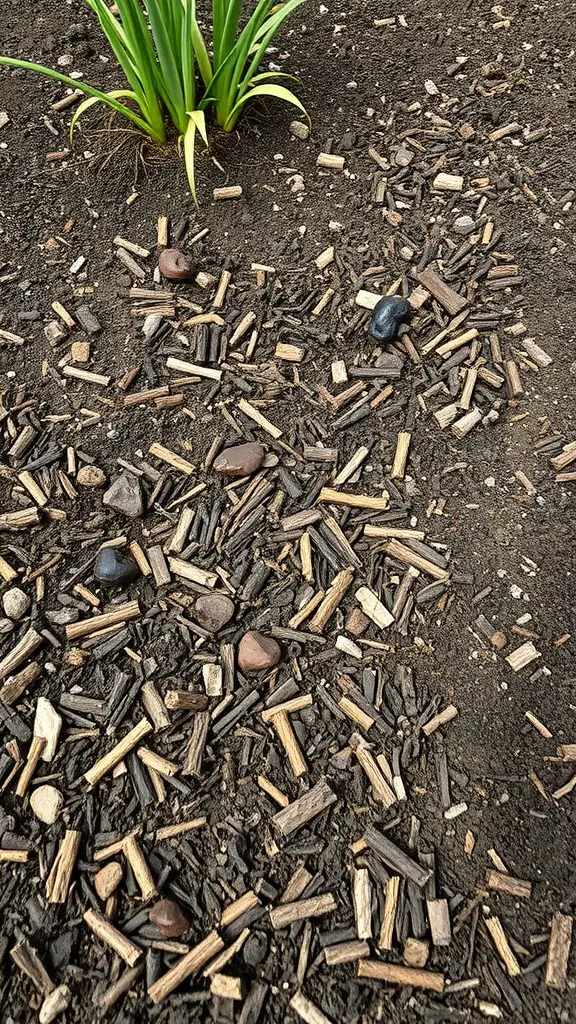
Preparing your soil is a key step in xeriscaping. The image shows a patch of soil with mulch and small stones scattered throughout. This setup helps retain moisture and provides a good base for drought-resistant plants.
Start by removing any weeds or grass in the area. This gives your new plants a better chance to thrive. After clearing the space, it’s important to loosen the soil. You can use a garden fork or tiller to break up compacted earth.
Next, consider adding organic matter like compost. This enriches the soil, helping it hold moisture better. The mulch seen in the image serves a similar purpose, preventing evaporation and keeping the roots cool.
Finally, test the soil pH if you can. Most xeriscape plants prefer slightly acidic to neutral soil. Adjusting the pH can make a big difference in how well your plants grow.
Incorporating Native Plants
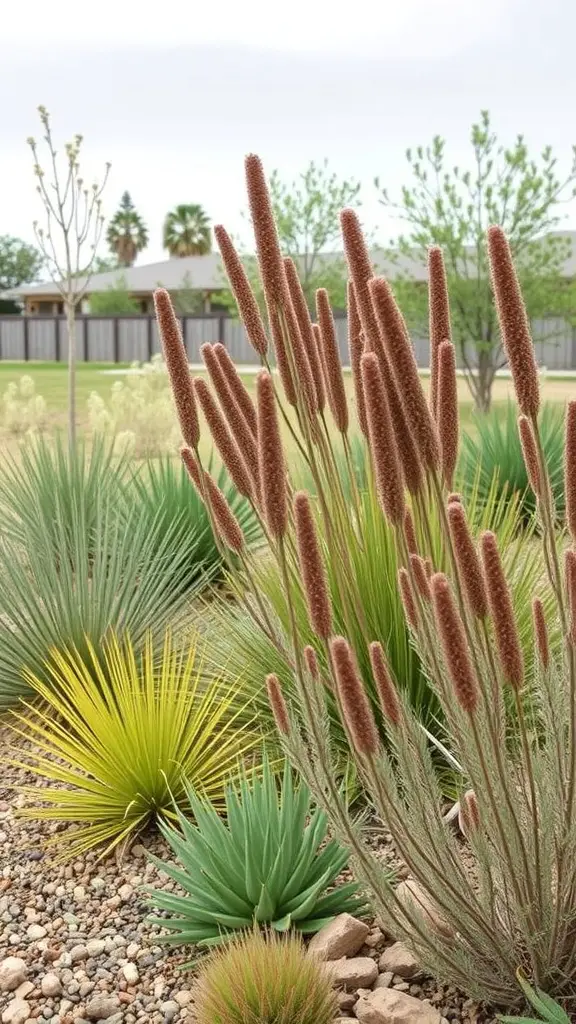
Xeriscape landscaping is all about creating a beautiful outdoor space that thrives with minimal water. One of the best ways to achieve this is by incorporating native plants. These plants are naturally adapted to the local climate and soil, making them easier to care for and more resilient.
The image shows a stunning arrangement of native plants, showcasing various textures and colors. You can see tall, fuzzy flower spikes that add height and interest, surrounded by spiky green foliage. This combination not only looks great but also supports local wildlife.
Using native plants in your xeriscape design means less watering and maintenance. They require less fertilizer and are more resistant to pests. Plus, they help maintain the local ecosystem, providing food and shelter for birds and insects.
When planning your xeriscape, consider what native plants thrive in your area. Research local species that fit your aesthetic and functional needs. This way, you’ll create a vibrant, sustainable landscape that reflects the beauty of your region.
Understanding Xeriscaping Principles
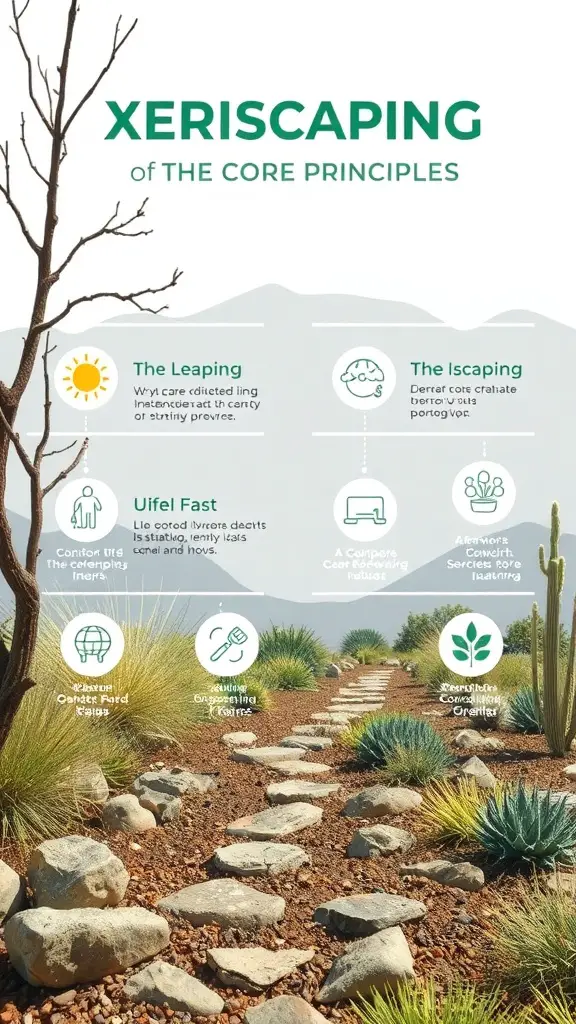
Xeriscaping is a landscaping approach that focuses on water conservation. The image shows key principles that guide this method. Each principle plays a role in creating a sustainable and beautiful outdoor space.
The first principle, ‘The Leaping,’ emphasizes the importance of planning. Understanding your landscape’s needs helps in choosing the right plants and materials. This ensures that your garden thrives with minimal water.
‘The Iscaping’ principle highlights the need for proper drainage. Good drainage prevents water from pooling and helps maintain healthy plants. This is essential for any xeriscape design.
Another core principle is ‘Utilizing Native Plants.’ These plants are adapted to local conditions, making them easier to care for. They require less water and are more resilient to local pests.
‘Creating Organized Spaces’ is also key. A well-structured garden not only looks appealing but also makes maintenance easier. Paths and plant arrangements should be designed for both beauty and function.
Lastly, ‘Strengthening Community Connections’ reminds us that xeriscaping can bring people together. Sharing tips and experiences can enhance the enjoyment of gardening while promoting sustainability.
Water Features in Xeriscape Design
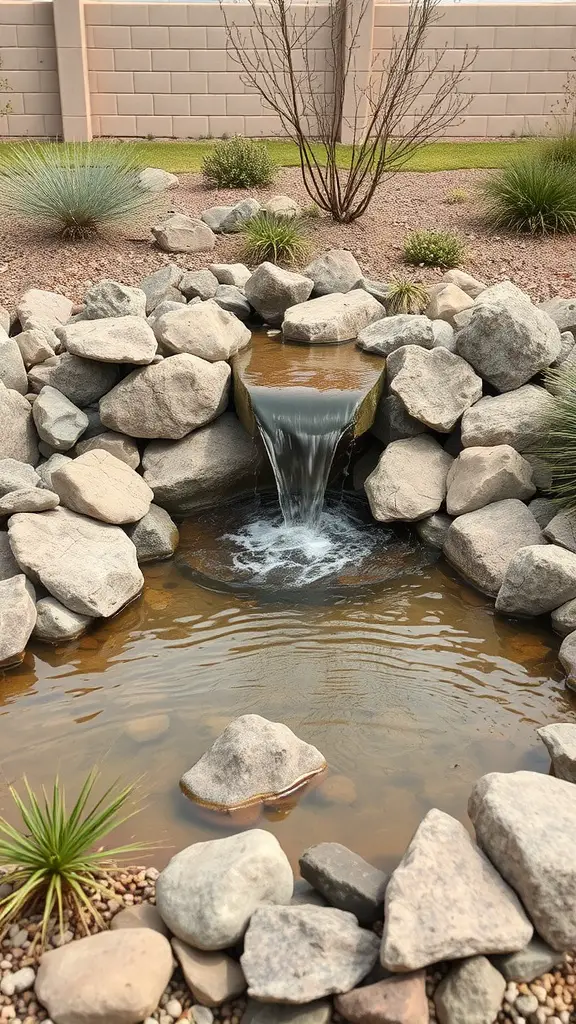
Water features can bring a refreshing touch to xeriscape landscaping. They not only provide visual interest but also create a soothing sound that enhances the outdoor experience.
The image shows a lovely water feature surrounded by natural stones. The gentle flow of water adds a calming element, making it a perfect spot for relaxation. The rocks help blend the feature into the surrounding landscape, maintaining a natural look.
In xeriscape design, water features can be designed to use minimal water while still offering beauty. This approach helps conserve resources, making it a smart choice for eco-conscious gardeners.
Consider adding plants that thrive in dry conditions around your water feature. This combination can create a balanced ecosystem that attracts beneficial wildlife, like birds and butterflies, enhancing the overall charm of your garden.
Using Gravel and Stone for Ground Cover
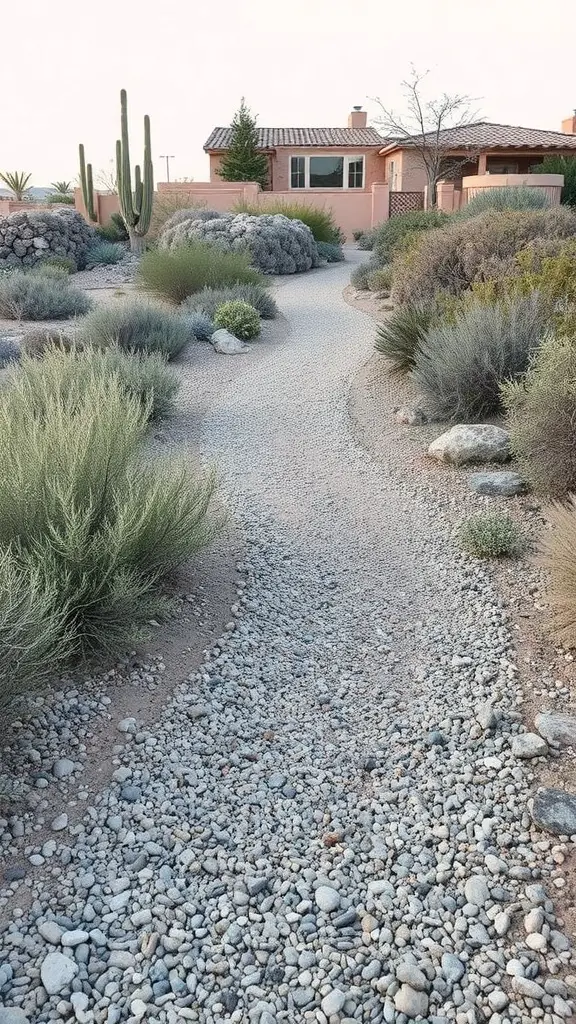
Gravel and stone are fantastic choices for ground cover in xeriscape landscaping. They not only look great but also help with water conservation. The image shows a beautiful path lined with gravel, leading through a variety of plants. This design is not just visually appealing; it also minimizes the need for irrigation.
Using gravel creates a natural, rustic feel. It allows rainwater to seep into the ground, reducing runoff and promoting healthy soil. The stones also help control weeds, making maintenance easier. In the image, you can see how the gravel complements the surrounding plants, creating a harmonious landscape.
Choosing the right type of gravel or stone can enhance your garden’s look. Larger stones can create a more dramatic effect, while smaller gravel can provide a softer appearance. The path in the image is a perfect example of how gravel can guide visitors through your garden while adding texture and interest.
Overall, gravel and stone are practical and stylish options for xeriscape landscaping. They help create a sustainable garden that thrives with minimal water. So, if you’re thinking about landscaping, consider incorporating these materials for a beautiful and eco-friendly design.
Efficient Irrigation Techniques
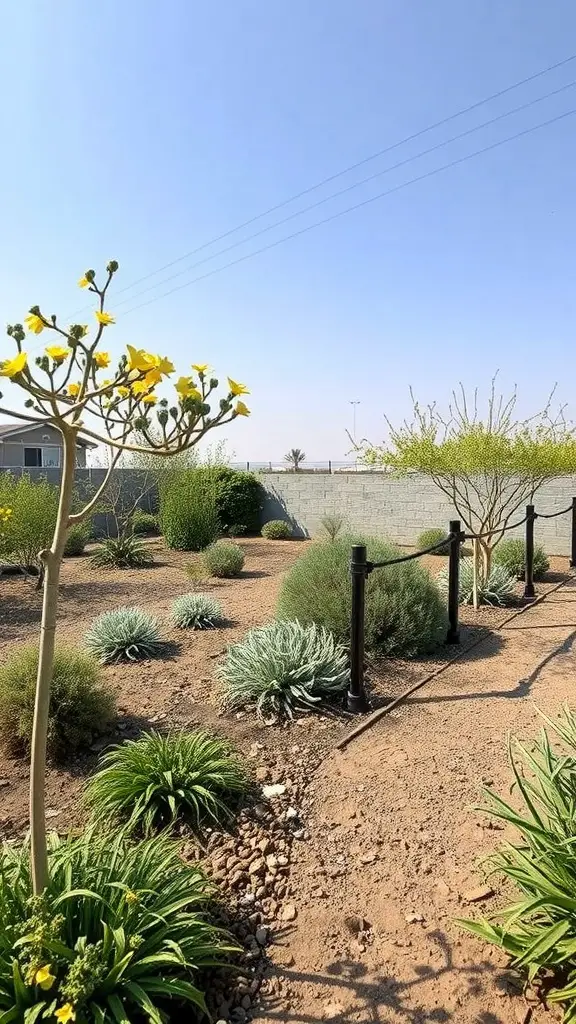
Xeriscape landscaping is all about creating a beautiful outdoor space while using minimal water. The image shows a well-planned xeriscape garden filled with various drought-resistant plants. Notice how the layout is designed to maximize water efficiency.
One effective technique is drip irrigation. This method delivers water directly to the roots of plants, reducing evaporation and runoff. You can see how the plants in the image are arranged to benefit from this kind of targeted watering.
Another approach is to use mulch around the plants. Mulch helps retain moisture in the soil and keeps the roots cool. In the image, the ground cover and rocky areas serve this purpose well, minimizing water loss.
Grouping plants with similar water needs is also a smart strategy. This way, you can water them together without wasting resources. The diverse plant life in the image showcases how different species can thrive together while still being water-wise.
Lastly, consider using rain barrels to collect runoff from your roof. This harvested water can be used to irrigate your xeriscape garden, making the most of natural resources. Overall, efficient irrigation techniques are key to maintaining a stunning xeriscape landscape.
Creating Microclimates in Your Garden
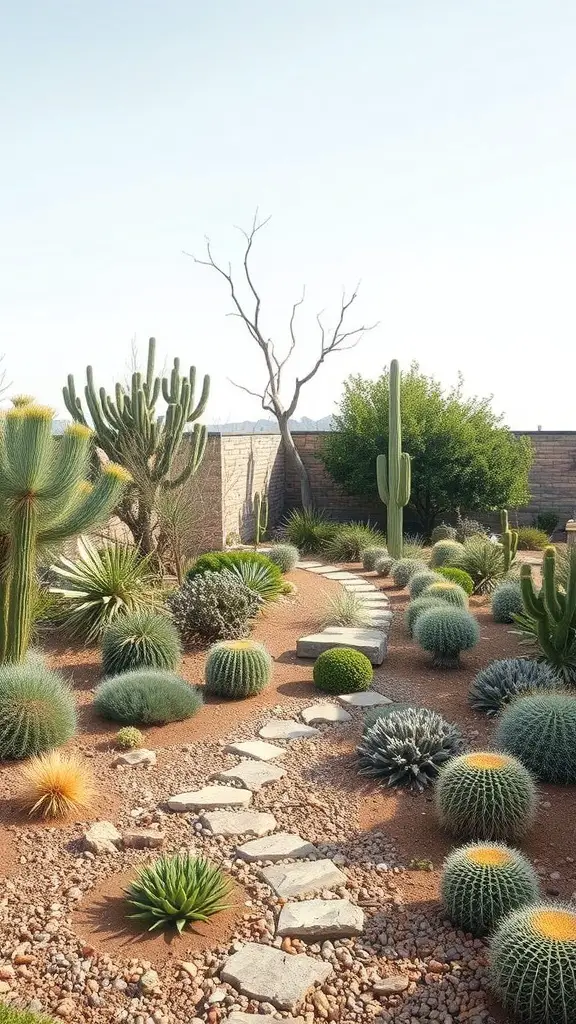
Creating microclimates in your garden can make a huge difference in plant health and growth. The image shows a beautiful xeriscape garden filled with various cacti and succulents. These plants thrive in dry conditions, making them perfect for regions with limited water.
The layout features a winding stone path that invites exploration. This design not only looks great but also helps to create different areas within the garden. Each section can have its own unique conditions, like sun exposure and moisture levels.
For instance, placing larger rocks can absorb heat during the day and release it at night, creating a warmer spot for more delicate plants. Meanwhile, shaded areas can be perfect for plants that prefer cooler conditions. This thoughtful arrangement helps to maximize the garden’s potential.
Using native plants is another smart choice. They are often well-adapted to local conditions, needing less water and care. This approach not only conserves resources but also supports local wildlife.
In summary, a xeriscape garden like the one in the image showcases how to create microclimates effectively. By considering the unique needs of different plants, you can cultivate a thriving, sustainable garden.
Choosing Drought-Resistant Plants
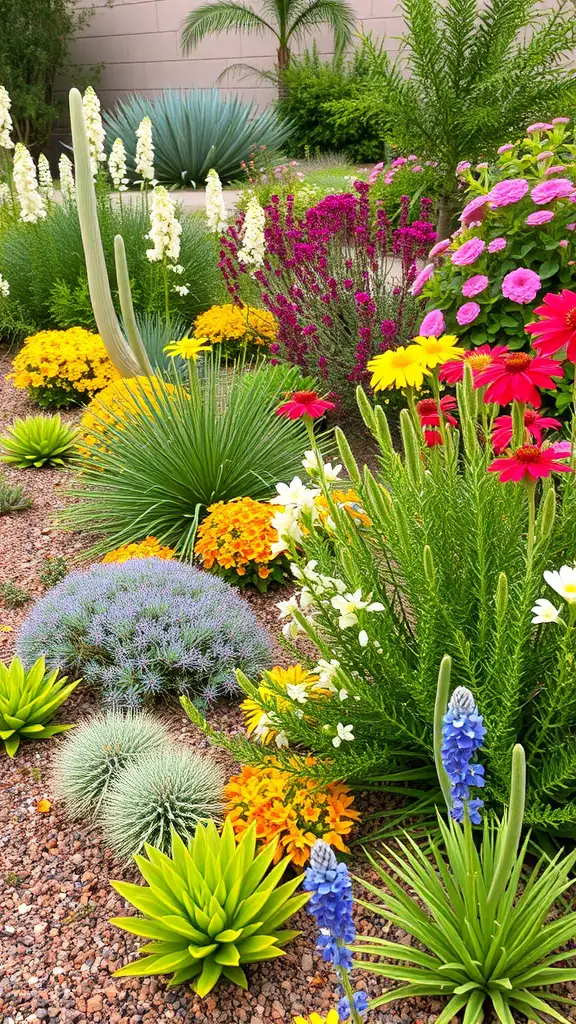
Xeriscape landscaping is all about creating beautiful gardens that thrive in dry conditions. The image shows a vibrant display of drought-resistant plants, showcasing how colorful and lively such gardens can be.
When selecting plants for your xeriscape, look for varieties that require minimal water. In the image, you can see a mix of succulents, colorful flowers, and hardy shrubs. These plants not only survive with little water but also add a burst of color to your outdoor space.
Consider native plants for your garden. They are well-adapted to the local climate and soil, making them easier to care for. The combination of textures and colors in the image highlights how diverse your plant choices can be.
Grouping plants with similar water needs is a smart strategy. This method helps you manage watering more efficiently. The plants in the image are arranged in a way that creates a stunning visual effect while being practical.
Finally, don’t forget about seasonal interest. Choose plants that bloom at different times of the year. This will keep your garden looking fresh and vibrant throughout the seasons. The image captures a lovely mix of blooming flowers and lush greenery, proving that xeriscaping can be both functional and beautiful.
Designing Pathways and Borders
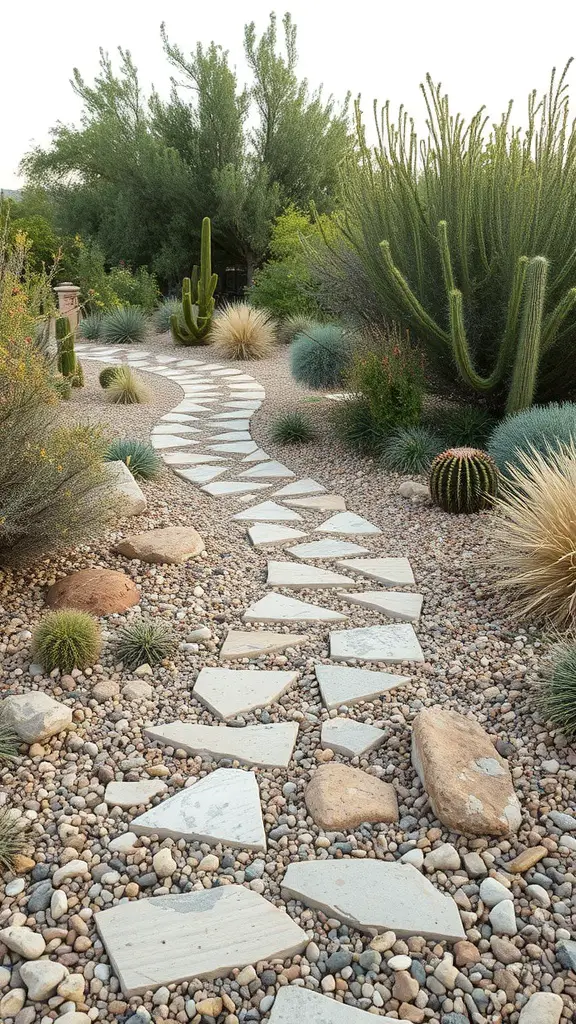
Creating pathways in xeriscape landscaping can really enhance the overall look of your garden. The image shows a beautifully designed stone path winding through a variety of drought-resistant plants. This kind of pathway not only adds visual interest but also provides a practical route through your garden.
Using natural stones for pathways blends well with the surrounding environment. The irregular shapes of the stones create a casual, inviting feel. This design encourages exploration and makes it easy to navigate around the different plantings.
In xeriscaping, pathways can also serve a functional purpose. They help manage water runoff and reduce soil erosion. By carefully placing stones and gravel, you can create a sustainable landscape that requires minimal maintenance.
Don’t forget to consider borders as well. Borders can define spaces and add structure to your garden. Using low-growing plants or decorative rocks can complement your pathways and enhance the overall aesthetic.
Creating a Xeriscape Plan
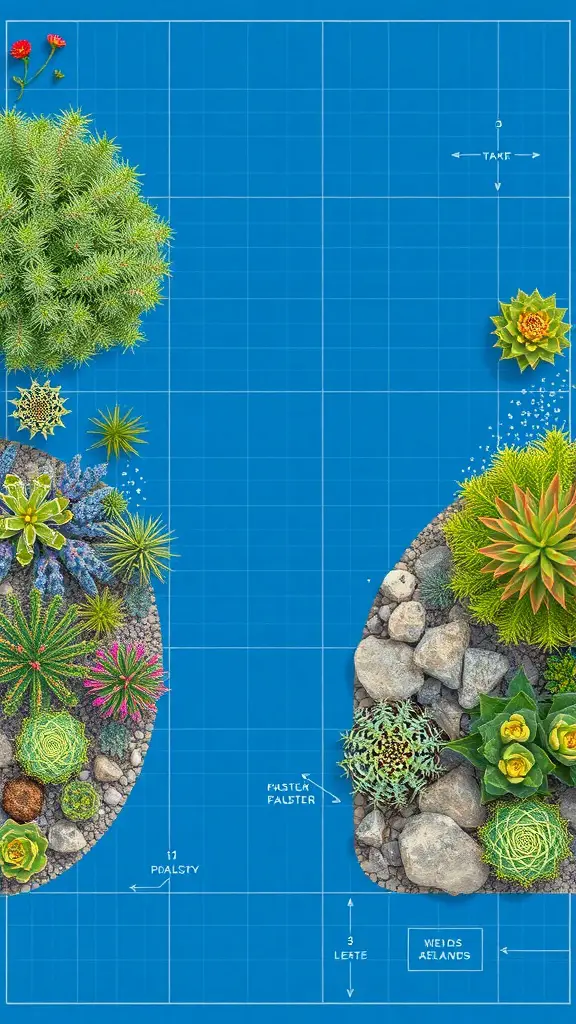
Creating a xeriscape plan is an exciting way to design a water-efficient garden. The image shows a blueprint layout filled with various plants and stones, which is a great starting point for your own xeriscaping project.
When planning your xeriscape, start by selecting drought-resistant plants. The colorful succulents and cacti in the image highlight how diverse and beautiful these plants can be. Consider your local climate and soil conditions to choose the right varieties.
Next, think about the layout. The grid pattern in the image helps visualize plant placement and spacing. Grouping plants with similar water needs can make maintenance easier and more efficient.
Don’t forget about hardscaping elements like rocks and pathways. They not only add visual interest but also help with drainage and reduce water loss. The stones in the image show how you can create a natural look while supporting your xeriscape design.
Finally, plan for irrigation. Even xeriscapes need water, especially when establishing new plants. Drip irrigation systems can be a great way to provide water directly to the roots without waste.
Xeriscaping with Succulents
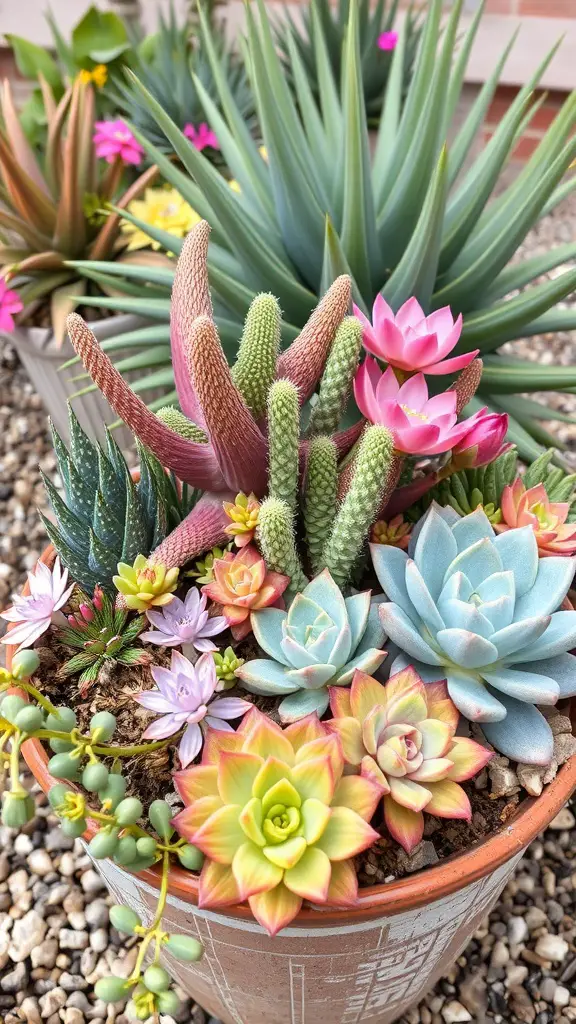
Xeriscaping is a fantastic way to create a beautiful garden while conserving water. Using succulents is one of the best choices for this type of landscaping. They come in various shapes, sizes, and colors, making them visually appealing.
The image shows a vibrant arrangement of succulents in a pot. You can see different varieties, each with unique textures and colors. This diversity not only adds beauty but also makes it easier to maintain. Succulents thrive in dry conditions, so they are perfect for xeriscaping.
When planning your xeriscape, consider grouping succulents with similar water needs. This helps in watering efficiently and keeps your garden looking fresh. You can also mix in some decorative stones or gravel to enhance the overall look.
Succulents are low-maintenance and can survive in various climates. They are ideal for anyone looking to create a stunning landscape without the hassle of constant care. Plus, they can be grown in pots, making them versatile for patios and balconies.
Benefits of Xeriscaping for the Environment
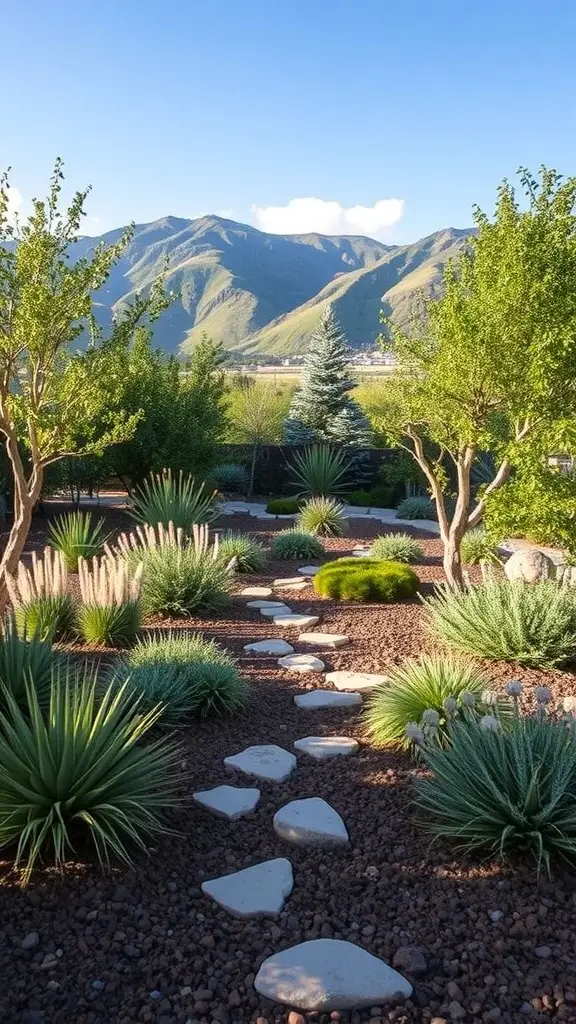
Xeriscaping is a fantastic way to create a beautiful landscape while being kind to the environment. The image shows a stunning xeriscape garden, featuring a variety of drought-resistant plants and a lovely stone pathway. This design not only looks great but also serves a purpose.
One of the biggest benefits of xeriscaping is water conservation. By using plants that thrive in dry conditions, you reduce the need for irrigation. This is especially important in areas where water is scarce. The garden in the image showcases how effective this can be, with lush greenery that requires minimal water.
Xeriscaping also supports local wildlife. Native plants attract beneficial insects and birds, creating a balanced ecosystem. The diverse plant life seen here provides food and shelter for various species, enhancing biodiversity in the area.
Moreover, xeriscaping can reduce maintenance costs. With less need for watering and mowing, homeowners can save both time and money. The low-maintenance nature of this garden allows for more enjoyment and less work.
Lastly, xeriscaping contributes to soil health. By choosing the right plants and using mulch, you can improve soil structure and prevent erosion. The garden depicted in the image is a perfect example of how thoughtful landscaping can lead to a healthier environment.
Seasonal Color in Xeriscaping
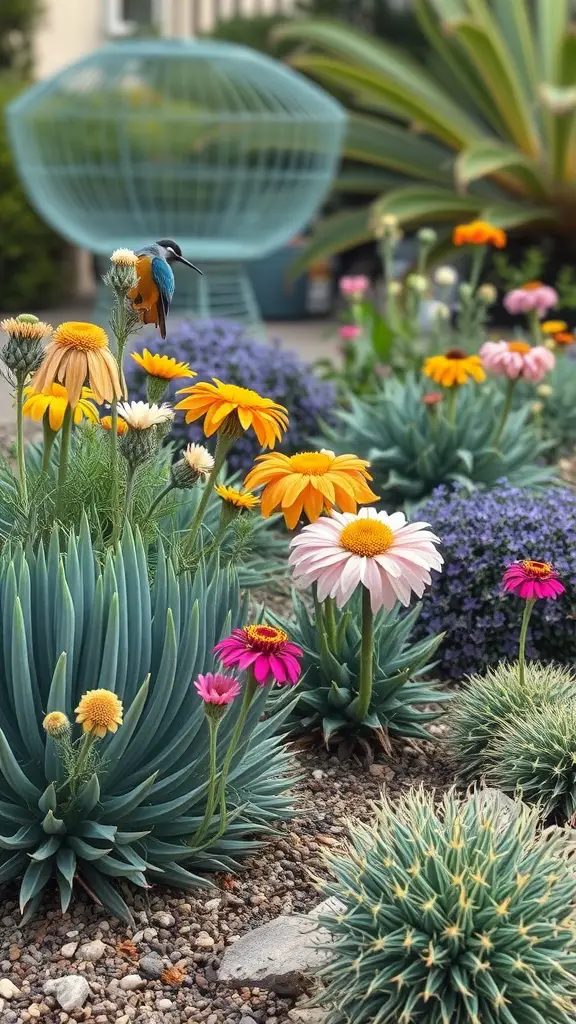
Xeriscaping is all about creating beautiful landscapes that thrive in dry conditions. One of the best parts of this approach is how it allows for seasonal color. The image shows a vibrant display of flowers, showcasing how diverse and colorful a xeriscape can be.
In the foreground, you can see a mix of daisies and other colorful blooms. These flowers not only add beauty but also attract pollinators like the bird perched nearby. This interaction brings life to the garden, making it a lively space.
The use of drought-resistant plants is key in xeriscaping. They require less water and are well-suited for different seasons. This means you can enjoy a variety of colors throughout the year without the stress of constant watering.
In the background, the unique structure adds an artistic touch to the landscape. It complements the natural elements, creating a harmonious balance. This blend of plants and design makes xeriscaping not just practical, but also visually appealing.
Xeriscape Maintenance Tips
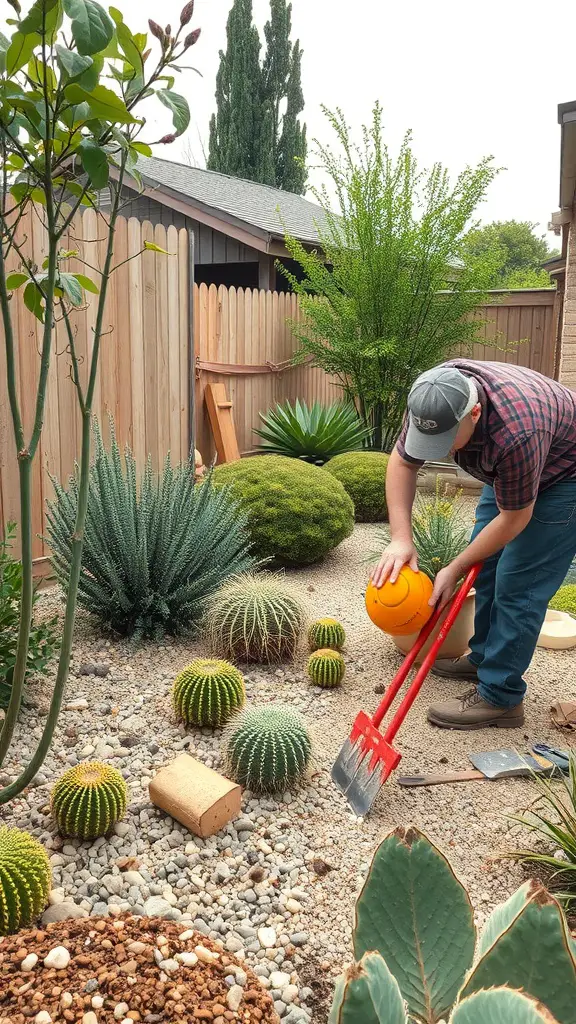
Xeriscaping is a smart way to create a beautiful garden while saving water. The image shows a person tending to a xeriscape garden filled with various drought-resistant plants. This kind of landscaping is not just eco-friendly; it can also be visually stunning.
To keep your xeriscape looking great, regular maintenance is key. Start by checking the soil moisture. Even drought-tolerant plants need some water, especially when they are newly planted. Use mulch to help retain moisture and suppress weeds.
Pruning is another important task. Trim back any dead or overgrown branches to encourage healthy growth. This also helps maintain the shape of your plants, keeping your garden looking tidy.
Weed control is essential too. Weeds can compete for nutrients and water, so pull them out regularly. Hand-pulling is often the best method, especially in a xeriscape garden where you want to avoid disturbing the soil too much.
Lastly, consider seasonal changes. Some plants may need more care during certain times of the year. Keep an eye on your garden and adjust your maintenance routine as needed.
Xeriscaping for Urban Spaces
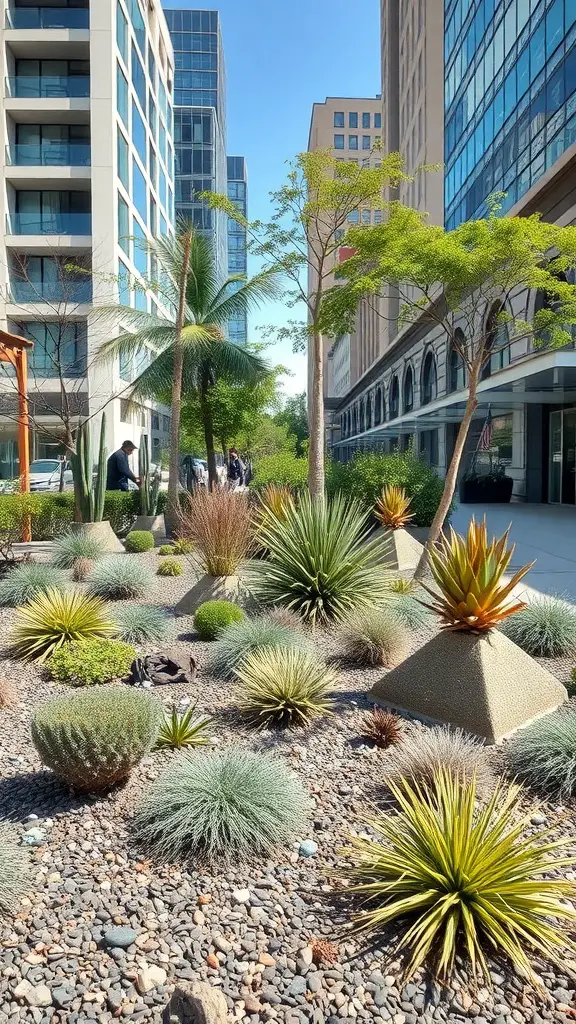
Xeriscaping is a smart choice for urban areas where water can be scarce. The image shows a vibrant xeriscape garden nestled between tall buildings. This design uses drought-resistant plants, making it both beautiful and practical.
The arrangement of various succulents and cacti creates a unique look. These plants thrive with minimal water, which is perfect for city living. The use of rocks as ground cover not only adds texture but also helps retain moisture in the soil.
Urban spaces can often feel concrete-heavy, but incorporating xeriscaping brings a touch of nature. It enhances the environment, providing a refreshing escape for city dwellers. Plus, it can help reduce heat in the area, making the surroundings more pleasant.
Choosing the right plants is key. Look for native species that are adapted to local conditions. This not only supports the ecosystem but also ensures a low-maintenance garden. With the right design, xeriscaping can transform any urban space into a green oasis.




